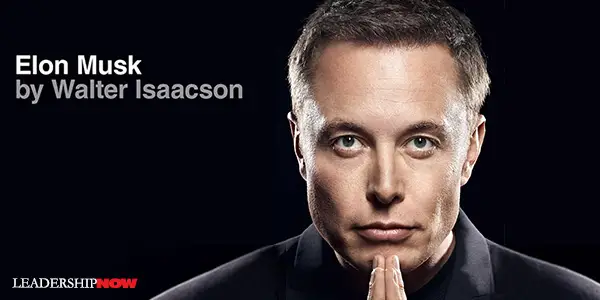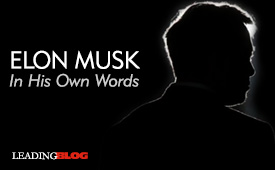02.26.24

Elon Musk by Walter Isaascson

LOVE HIM or hate him, Elon Musk is not easily dismissed. While there is genius in his high-tech visions, some of his opinions and antics leave some people disturbed if for no other reason than they don’t align with their own.
Walter Isaacson’s biography of Elon Musk is full of revealing, behind-the-scenes anecdotes that provide insight into why Musk does what he does and why he does it that way. Even though Musk’s approach doesn’t necessarily provide a blueprint to be copied any more than Steve Jobs’ approach did (even though both individuals got results), it does offer lessons to be learned and applied in our own leadership.
Musk remarked on Saturday Night Live in May of 2021, “To anyone I’ve offended, I just want to say, I reinvented electric cars and I’m sending people to Mars in a rocket ship. Did you think I was also going to be a chill normal dude?”
Below, you will find some excerpts that give you a taste of what you will find in Isaacson’s Elon Musk.
Growing up:
“With a childhood like his in South Africa, I think you have to shut yourself down emotionally in some ways,” says his first wife, Justine, the mother of five of his surviving ten children. “If your father is always calling you a moron and idiot, maybe the only response is to turn off anything inside that would’ve opened up an emotional dimension that he didn’t have tools to deal with.” This emotional shutoff valve could make him callous, but it also made him a risk-seeking innovator. “He learned to shut down fear,” she says. “If you turn off fear, then maybe you have to turn off other things, like joy, or empathy.”
“Adversity shaped me,” Musk says. “My pain threshold becomes very high.”
Some of the words Elon uses, the way he stares, his sudden transitions from light to dark to light, remind his family members of the Errol [father] simmering inside of him. “I would see shades of these horrible stories Elon told me surface in his own behavior,” says Justine, Elon’s first wife. “It made me realize how difficult it is not to be shaped by what we grew up with, even when that’s not what we want.”
Confinity [PayPal] cofounder Max Levchin recalls, “Elon will say crazy stuff, but every once in a while, he’ll surprise you by knowing way more than you do about your own specialty. I think a huge part of the way he motivates people are these displays of sharpness, which people just don’t expect him, because they mistake him for a bullshitter or goofball.”
“Entrepreneurs are actually not risk takers,” says X.com CFO Roelof Botha. “They’re risk mitigators. They never seek to amplify it, instead, they try to figure out the controllable wiles minimize their risk.” But not Musk. “He was into amplifying and burning the boats so we could never retreat from it.” “It would be a theme in his life: chips off the table; keep risking them.”
He was a visionary who didn’t play well with others.
Reid Hoffman, another PayPal veteran observed, “What I didn’t appreciate is that Elon starts with a mission and later finds a way to backfill in order to make it work financially. That’s what makes him a force of nature.”
Max Levchin says, “One of Elon’s greatest skills is the ability to pass off his vision as a mandate from heaven.”
First principles and the Idiot Index:
As he stewed about the absurd price the Russians wanted to charge, he employed some first-principles thinking, drilling down to the basic physics of the situation and building up from there. This led him to develop what he called an “idiot index,” which calculated how much costly a finished product was than the cost of its basic materials. If a product had a high idiot index, its cost could be reduced significantly by devising more efficient manufacturing techniques.
If you’re unwilling to invest in a company, he felt, you shouldn’t qualify as a founder. “You cannot ask for two years of salary in escrow and consider yourself a cofounder,” he says. “There’s got to be some combination of inspiration, perspiration, and risk to be a cofounder.”
As his team grew, Musk infused it with his tolerance for risk and reality-bending willfulness. “If you were negative or thought something couldn’t be done, you were not invited to the next meeting, SpaceX Tom Mueller recalls. “He just wanted people who would make things happen.” It was a good way to drive people to do what they thought was impossible. But it was also a good way to become surrounded by people afraid to give you bad news or question a decision.
A maniacal sense of urgency is our operating principle,” he repeatedly declared. The sense of urgency was good for its own sake. It made his engineers engage in first-principles thinking.
Musk’s focus was on root causes. What in the design was to blame for a production-line problem?
Musk liked to focus on work. At times, he treated the rest of his life as an unpleasant distraction.
“If conventional thinking makes your mission impossible,” Musk told him, “then unconventional thinking is necessary.”
The Algorithm
“I became a broken record on the algorithm,” Musk says. “But I think it’s helpful to say it to an annoying degree.” It had five commandments: Question every requirement. 2. Delete any part or process you can. You may have to add them back later. 3. Simplify and optimize. 4. Accelerate cycle time. 5. Automate. That comes last.
If you don’t end up having to restore 10 percent of the parts you deleted, then you didn’t delete enough.
It's OK to be wrong. Just don’t be confident and wrong.
Hiring, look for people with the right attitude. Skills can taught. Attitude changes require a brain transplant.
“One of Elon’s rules is, go as close to the source as possible for information.”
“Precision is not expensive,” he says. “It’s mostly about caring Do you care to make it precise? Then you can make it precise.”
The biggest change Musk wrought was to put the design engineers in charge of production, like he had done for a while at Tesla. I created separate design and production groups a long time ago, and that was a bullshit mistake,” he said at one of the first meetings that McKenzie led. “You are responsible for the production process. You can’t hand it off to someone else. If the design is expensive to produce, you change the design.”
Although stubborn, Musk can be brought around by evidence.
When things were most dire, he got energized. It was the siege mentality of his South African childhood. But when he was in survival-or-die mode, he felt unsettled. What should have been the good times were unnerving for him. It prompted him to launch surges, stir up dramas, throw himself into battles he could have bypassed, and bite off new endeavors.
Discomfort, he believed, was a good thing. It was a weapon against the scourge of complacency. Vacations, flower-smelling, work-life balance, and days of “mental rest” were not his thing. Let that sink in.
The value of serendipity and of showing up in person: “Me and James and the people on our Autopilot team are always sitting together, and ideas flow real fast, and what we do as a team is better than what any one of us could do,” he said. Andrew noted that was why Musk favored in-person rather than remote work.
Isaacson concludes with this observation of Musk:
One can admire a person’s good traits and decry the bad ones. But it’s also important to understand how the strands are woven together, sometimes tightly. It can be hard to remove the dark ones without unraveling the whole cloth. As Shakespeare teaches us, all heroes have flaws, some tragic, some conquered, and those we cast as villains can be complex. Even the best people, he wrote, are “molded out of faults.”
* * *  Follow us on Instagram and Twitter for additional leadership and personal development ideas.
* * *


 
Posted by Michael McKinney at 01:30 PM
Permalink
| Comments (0)
| This post is about Leaders
|
 |
BUILD YOUR KNOWLEDGE
ADVERTISE WITH US






How to Do Your Start-Up Right
STRAIGHT TALK FOR START-UPS



Grow Your Leadership Skills
NEW AND UPCOMING LEADERSHIP BOOKS

Leadership Minute
BITE-SIZE CONCEPTS YOU CAN CHEW ON

Classic Leadership Books
BOOKS TO READ BEFORE YOU LEAD
|
 |
|










